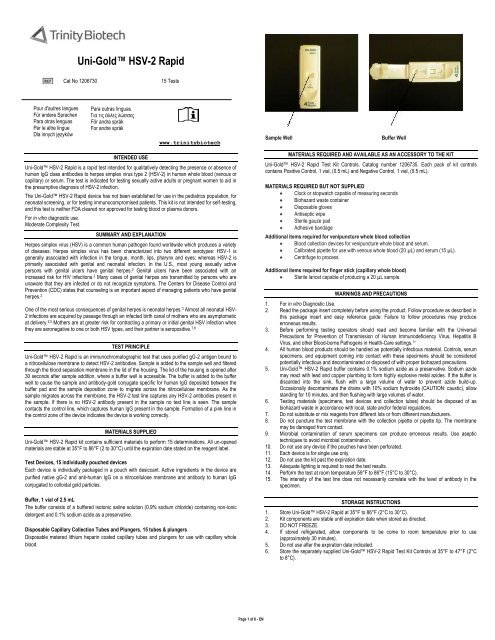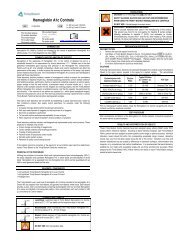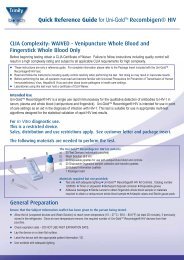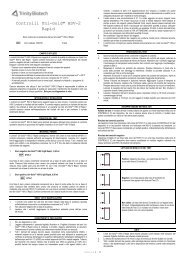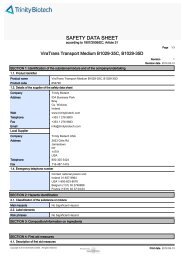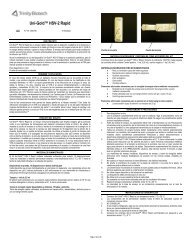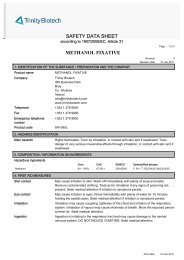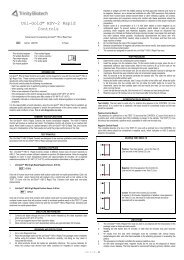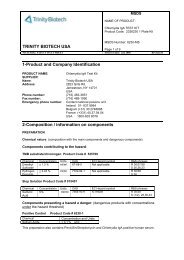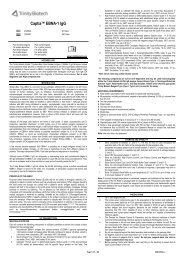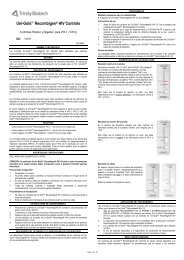Uni-Gold™ HSV-2 Rapid - Trinity Biotech PLC
Uni-Gold™ HSV-2 Rapid - Trinity Biotech PLC
Uni-Gold™ HSV-2 Rapid - Trinity Biotech PLC
You also want an ePaper? Increase the reach of your titles
YUMPU automatically turns print PDFs into web optimized ePapers that Google loves.
<strong>Uni</strong>-Gold <strong>HSV</strong>-2 <strong>Rapid</strong><br />
Cat No 1206730<br />
15 Tests<br />
Pour d'autres langues<br />
Für andere Sprachen<br />
Para otras lenguas<br />
Per le altre lingue<br />
Dla innych języków<br />
INTENDED USE<br />
<strong>Uni</strong>-Gold <strong>HSV</strong>-2 <strong>Rapid</strong> is a rapid test intended for qualitatively detecting the presence or absence of<br />
human IgG class antibodies to herpes simplex virus type 2 (<strong>HSV</strong>-2) in human whole blood (venous or<br />
capillary) or serum. The test is indicated for testing sexually active adults or pregnant women to aid in<br />
the presumptive diagnosis of <strong>HSV</strong>-2 infection.<br />
The <strong>Uni</strong>-Gold <strong>HSV</strong>-2 <strong>Rapid</strong> device has not been established for use in the pediatrics population, for<br />
neonatal screening, or for testing immunocompromised patients. This kit is not intended for self-testing,<br />
and this test is neither FDA cleared nor approved for testing blood or plasma donors.<br />
For in vitro diagnostic use.<br />
Moderate Complexity Test.<br />
Para outras línguas<br />
Για τις άλλες λώσσες<br />
För andra språk<br />
For andre språk<br />
SUMMARY AND EXPLANATION<br />
Herpes simplex virus (<strong>HSV</strong>) is a common human pathogen found worldwide which produces a variety<br />
of diseases. Herpes simplex virus has been characterized into two different serotypes: <strong>HSV</strong>-1 is<br />
generally associated with infection in the tongue, month, lips, pharynx and eyes; whereas <strong>HSV</strong>-2 is<br />
primarily associated with genital and neonatal infection. In the U.S., most young sexually active<br />
persons with genital ulcers have genital herpes. 2 Genital ulcers have been associated with an<br />
increased risk for HIV infections. 2 Many cases of genital herpes are transmitted by persons who are<br />
unaware that they are infected or do not recognize symptoms. The Centers for Disease Control and<br />
Prevention (CDC) states that counseling is an important aspect of managing patients who have genital<br />
herpes. 2<br />
One of the most serious consequences of genital herpes is neonatal herpes. 3 Almost all neonatal <strong>HSV</strong>-<br />
2 infections are acquired by passage through an infected birth canal of mothers who are asymptomatic<br />
at delivery. 2,5 Mothers are at greater risk for contracting a primary or initial genital <strong>HSV</strong> infection when<br />
they are seronegative to one or both <strong>HSV</strong> types, and their partner is seropositive. 7,8<br />
TEST PRINCIPLE<br />
<strong>Uni</strong>-Gold <strong>HSV</strong>-2 <strong>Rapid</strong> is an immunochromatographic test that uses purified gG-2 antigen bound to<br />
a nitrocellulose membrane to detect <strong>HSV</strong>-2 antibodies. Sample is added to the sample well and filtered<br />
through the blood separation membrane in the lid of the housing. The lid of the housing is opened after<br />
30 seconds after sample addition, where a buffer well is accessible. The buffer is added to the buffer<br />
well to cause the sample and antibody-gold conjugate specific for human IgG deposited between the<br />
buffer pad and the sample deposition zone to migrate across the nitrocellulose membrane. As the<br />
sample migrates across the membrane, the <strong>HSV</strong>-2 test line captures any <strong>HSV</strong>-2 antibodies present in<br />
the sample. If there is no <strong>HSV</strong>-2 antibody present in the sample no test line is seen. The sample<br />
contacts the control line, which captures human IgG present in the sample. Formation of a pink line in<br />
the control zone of the device indicates the device is working correctly.<br />
MATERIALS SUPPLIED<br />
www.trinitybiotech<br />
.com<br />
<strong>Uni</strong>-Gold <strong>HSV</strong>-2 <strong>Rapid</strong> kit contains sufficient materials to perform 15 determinations. All un-opened<br />
materials are stable at 35°F to 86°F (2 to 30°C) until the expiration date stated on the reagent label.<br />
Test Devices, 15 individually pouched devices<br />
Each device is individually packaged in a pouch with desiccant. Active ingredients in the device are<br />
purified native gG-2 and anti-human IgG on a nitrocellulose membrane and antibody to human IgG<br />
conjugated to colloidal gold particles.<br />
Buffer, 1 vial of 2.5 mL<br />
The buffer consists of a buffered isotonic saline solution (0.9% sodium chloride) containing non-ionic<br />
detergent and 0.1% sodium azide as a preservative.<br />
Disposable Capillary Collection Tubes and Plungers, 15 tubes & plungers<br />
Disposable metered lithium heparin coated capillary tubes and plungers for use with capillary whole<br />
blood.<br />
Sample Well<br />
Buffer Well<br />
MATERIALS REQUIRED AND AVAILABLE AS AN ACCESSORY TO THE KIT<br />
<strong>Uni</strong>-Gold <strong>HSV</strong>-2 <strong>Rapid</strong> Test Kit Controls. Catalog number 1206735. Each pack of kit controls<br />
contains Positive Control, 1 vial, (0.5 mL) and Negative Control, 1 vial, (0.5 mL).<br />
MATERIALS REQUIRED BUT NOT SUPPLIED<br />
Clock or stopwatch capable of measuring seconds<br />
Biohazard waste container<br />
Disposable gloves<br />
Antiseptic wipe<br />
Sterile gauze pad<br />
Adhesive bandage<br />
Additional items required for venipuncture whole blood collection<br />
Blood collection devices for venipuncture whole blood and serum.<br />
Calibrated pipette for use with venous whole blood (20 µL) and serum (15 µL).<br />
Centrifuge to process.<br />
Additional items required for finger stick (capillary whole blood)<br />
Sterile lancet capable of producing a 20 µL sample.<br />
WARNINGS AND PRECAUTIONS<br />
1. For in vitro Diagnostic Use.<br />
2. Read the package insert completely before using the product. Follow procedure as described in<br />
this package insert and easy reference guide. Failure to follow procedures may produce<br />
erroneous results.<br />
3. Before performing testing operators should read and become familiar with the <strong>Uni</strong>versal<br />
Precautions for Prevention of Transmission of Human Immunodeficiency Virus, Hepatitis B<br />
Virus, and other Blood-borne Pathogens in Health-Care settings. 11<br />
4. All human blood products should be handled as potentially infectious material. Controls, serum<br />
specimens, and equipment coming into contact with these specimens should be considered<br />
potentially infectious and decontaminated or disposed of with proper biohazard precautions.<br />
5. <strong>Uni</strong>-Gold <strong>HSV</strong>-2 <strong>Rapid</strong> buffer contains 0.1% sodium azide as a preservative. Sodium azide<br />
may react with lead and copper plumbing to form highly explosive metal azides. If the buffer is<br />
discarded into the sink, flush with a large volume of water to prevent azide build-up.<br />
Occasionally decontaminate the drains with 10% sodium hydroxide (CAUTION: caustic), allow<br />
standing for 10 minutes, and then flushing with large volumes of water.<br />
6. Testing materials (specimens, test devices and collection tubes) should be disposed of as<br />
biohazard waste in accordance with local, state and/or federal regulations.<br />
7. Do not substitute or mix reagents from different lots or from different manufacturers.<br />
8. Do not puncture the test membrane with the collection pipette or pipette tip. The membrane<br />
may be damaged from contact.<br />
9. Microbial contamination of serum specimens can produce erroneous results. Use aseptic<br />
techniques to avoid microbial contamination.<br />
10. Do not use any device if the pouches have been perforated.<br />
11. Each device is for single use only.<br />
12. Do not use the kit past the expiration date.<br />
13. Adequate lighting is required to read the test results.<br />
14. Perform the test at room temperature 59°F to 86°F (15°C to 30°C).<br />
15. The intensity of the test line does not necessarily correlate with the level of antibody in the<br />
specimen.<br />
STORAGE INSTRUCTIONS<br />
1. Store <strong>Uni</strong>-Gold <strong>HSV</strong>-2 <strong>Rapid</strong> at 35°F to 86°F (2°C to 30°C).<br />
2. Kit components are stable until expiration date when stored as directed.<br />
3. DO NOT FREEZE.<br />
4. If stored refrigerated, allow components to be come to room temperature prior to use<br />
(approximately 30 minutes).<br />
5. Do not use after the expiration date indicated.<br />
6. Store the separately supplied <strong>Uni</strong>-Gold <strong>HSV</strong>-2 <strong>Rapid</strong> Test Kit Controls at 35°F to 47°F (2°C<br />
to 8°C).<br />
Page 1 of 6 - EN
SPECIMEN COLLECTION AND PREPARATION<br />
Only capillary or venous whole blood or serum can be used to perform this test. Collect samples<br />
aseptically using approved sample collection techniques<br />
WHOLE BLOOD COLLECTED BY FINGER STICK<br />
Collect blood samples aseptically using approved techniques. 19,20 Use an antiseptic wipe to clean the<br />
finger. Allow the finger to dry thoroughly or wipe dry with a sterile gauze pad. Use a sterile lancet<br />
capable of producing enough blood droplets to fill the 20 µL collection tube. Puncture the skin just off<br />
the center of the finger pad. Hold the finger downward. Apply gentle pressure beside the point of<br />
puncture. Avoid squeezing the finger to make it bleed. Wipe away the first drop of blood with a sterile<br />
gauze pad. Allow a new drop of blood to form. Massage at the finger base to produce a droplet of<br />
sufficient volume if blood flow is inadequate. Avoid "milking" the finger. Whole blood collected by finger<br />
stick should be used on the <strong>Uni</strong>-Gold <strong>HSV</strong>-2 <strong>Rapid</strong> immediately after collection.<br />
WHOLE BLOOD COLLECTED BY VENIPUNCTURE<br />
Collect blood samples aseptically using approved venipuncture techniques by qualified personnel. 12<br />
Collect a venipuncture whole blood specimen using a blood collection tube containing EDTA (lavender<br />
top). Other anticoagulants have not been tested and may give incorrect results. If the specimens are<br />
not tested at the time of collection, the whole blood may be stored at 35°F to 47°F (2°C to 8°C) for up<br />
to 48 hours. Prior to testing, mix the blood tube gently by inversion several times to ensure a<br />
homogeneous sample.<br />
SERUM<br />
Collect blood samples aseptically using approved venipuncture techniques by qualified personnel. 12<br />
Collect a venipuncture whole blood specimen using a blood collection tube without coagulants. Allow<br />
blood sample to clot at room temperature before centrifugation. Aseptically transfer serum to a tightly<br />
closing sterile container for storage. Separated serum should remain at room temperature 59°F to<br />
86°F (15°C to 30°C) for no longer than 4 hours. If the assay will not be completed within 48 hours, or<br />
for shipment of samples, freeze at -4°F (-20°C) or colder. Thaw and mix samples well prior to use.<br />
Avoid multiple freeze thaw cycles. Hyperlipemic, heat-inactivated, hemolyzed or contaminated sera<br />
should not be used.<br />
Serum Storage Conditions are as follows:<br />
Room Temperature 59°F to 86°F (15°C to 30°C): 4 hours<br />
Refrigerate 35°F to 47°F (2°C to 8°C): 8 hours (bring sample to room temperature before use.)<br />
Freeze < -4°F (< -20°C): 2 months (thaw and bring samples to room temperature prior to using) .<br />
PROCEDURE<br />
PROCEDURAL NOTES<br />
1. Do not use the test after the expiration date.<br />
2. Store the test kit at 35°F to 86°F (2°C to 30°C). Do not freeze. Allow approximately 30 minutes<br />
for test kit to come to room temperature, if refrigerated, before use.<br />
3. Use the test within 2 hours after removing the test device from the pouch.<br />
4. Do not open top of test device prior to adding sample.<br />
5. Do not damage the test membrane.<br />
6. Place the device horizontally on a flat surface while performing the test.<br />
7. Use a separate collection tube for each sample.<br />
8. Hold collection tube and buffer bottle vertically to dispense blood and buffer onto the test<br />
device.<br />
9. Ensure the collection tube is directly over the sample well before depressing the plunger.<br />
Insufficient sample quantities may result in invalid results.<br />
10. Do not touch collection tube tip or buffer bottle tip directly to the test membrane.<br />
ASSAY PROCEDURE<br />
Tear open the foil pouch and place the test device on a flat horizontal surface. Discard desiccant.<br />
1. Use the disposable Mylar-wrapped blood collection tube provided in the kit for collection<br />
of whole blood capillary (finger stick) samples.<br />
Insert the plunger into the collection tube. Place the tip of the collection tube into the sample.<br />
The sample should fill to the mark on the collection tube. If the sample is not collected to the<br />
mark, the collection tube should be discarded and another specimen should be collected from<br />
another finger by repeating the sample collection process. Transfer the entire contents<br />
(approximately 20 µL) of whole blood to the sample well by pushing down on the plunger. Do<br />
not allow the collection tube tip to damage the membrane. Discard the used collection tube<br />
into a biohazard waste receptacle. For venous whole blood use a calibrated laboratory transfer<br />
pipette to deliver 20 µL of sample to the sample addition well. For serum, use a calibrated<br />
laboratory transfer pipette to deliver 15 µL of sample to the sample addition well.<br />
2. Wait 30 seconds to let the sample penetrate the sample well. Open the device top (uncovering<br />
the buffer addition well).<br />
3. Add 5 drops of buffer to the buffer well. Allow the buffer to fall drop-wise onto the buffer well. Do<br />
not allow the buffer bottle tip to touch the membrane. Leave the test device open until test<br />
results are read.<br />
4. Leave the test device lying flat. Set the timer for 15 minutes and start timing the test.<br />
5. Read the result at 15 minutes, but do not read result after more than 20 minutes.<br />
3. A positive TEST (T) line may develop before 15 minutes, if the CONTROL (C) line is observed;<br />
the test may be read as positive.<br />
External Quality Control<br />
<strong>Uni</strong>-Gold <strong>HSV</strong>-2 <strong>Rapid</strong> Test Kit Controls (Catalog No. 1206735) are available separately for use only<br />
with the <strong>Uni</strong>-Gold <strong>HSV</strong>-2 <strong>Rapid</strong> Test Kit. The kit controls are used to verify your ability to perform the<br />
test and interpret the test result. Controls should be tested by the same procedure as patient samples.<br />
Use of kit control reagents manufactured by any other source may not produce the required results.<br />
The positive control should produce a weak to moderate positive TEST line (T) combined with a clearly<br />
visible CONTROL (C) line. The negative control should produce a clearly visible CONTROL (C) line<br />
combined with no visible line on the Test (T) line.<br />
Run the kit control under the following circumstances: 18<br />
Each new operator prior to performing testing on patient specimens.<br />
When opening a new test kit lot.<br />
When a new shipment of test kits is received.<br />
If the temperature of the test kit storage area falls outside of 35°F to 86°F (2°C to 30°C).<br />
If the temperature of the testing area falls outside of 59°F to 86°F (15°C to 30°C).<br />
At periodic intervals in conformance with local, state and/or Federal regulations or accreditation<br />
programs.<br />
Refer to the <strong>Uni</strong>-Gold <strong>HSV</strong>-2 <strong>Rapid</strong> Test Kit Controls package insert for instructions on the use of<br />
these reagents. It is the responsibility of each laboratory using the <strong>Uni</strong>-Gold <strong>HSV</strong>-2 <strong>Rapid</strong> Test Kit to<br />
establish an adequate quality assurance program to ensure the performance of the device under its<br />
specific locations and conditions of use.<br />
For assistance or additional information about user controls, contact <strong>Trinity</strong> <strong>Biotech</strong> Technical Services<br />
at (800) 325-3424.<br />
INTERPRETATION OF RESULTS<br />
Test Validity: The test result is only valid if a pink/red line appears in the CONTROL (C) line of the<br />
device. If no CONTROL (C) line is observed, the result should be considered invalid and the test<br />
should be repeated.<br />
Positive Result<br />
The presence of a pink/red line in the TEST (T) line and the CONTROL (C) line of the device is a<br />
positive test, which indicates that <strong>HSV</strong>-2 antibody is present in the sample. The TEST (T) line l should<br />
be considered a positive result, regardless of width over the test strip.<br />
Negative Result<br />
The complete absence of a line in the TEST (T) line with a pink/red line in the CONTROL (C) line of<br />
the device should be considered a negative result, which indicates no <strong>HSV</strong>-2 antibody present in the<br />
sample.<br />
T<br />
C<br />
T<br />
C<br />
T<br />
C<br />
T<br />
C<br />
READING TEST RESULTS<br />
Positive: Two lines appear - one in the Test (T)<br />
Line and one in the Control (C) Line.<br />
Negative: One line appears in the Control (C)<br />
Line and no line appears in the Test (T) Line.<br />
Invalid: The line in the Control (C) Line fails<br />
to appear in 20 minutes. Regardless of whether a line appears in<br />
the Test (T) Line, the result is invalid and the test should be<br />
repeated with a new cassette.<br />
Built-in Control Features<br />
QUALITY CONTROL<br />
<strong>Uni</strong>-Gold <strong>HSV</strong>-2 <strong>Rapid</strong> has a built-in procedural control that demonstrates assay validity. A pink/red<br />
line in the CONTROL (C) line indicates that the test is running correctly. Test results are invalid if there<br />
is no control line. Invalid tests should be repeated.<br />
1. The CONTROL (C) line is NOT an internal reference for test result line intensity.<br />
2. The CONTROL (C) line may appear before 15 minutes. It is important to wait at least 15<br />
minutes prior to reading a negative result.<br />
LIMITATIONS<br />
The <strong>Uni</strong>-Gold <strong>HSV</strong>-2 <strong>Rapid</strong> Test must be used in accordance with the instructions in this package<br />
insert to obtain accurate results.<br />
1. The performance of this assay has not been established for the general population.<br />
2. The performance of this assay has not been established for monitoring <strong>HSV</strong>-2 therapy.<br />
3. Cross-reactivity testing of this assay has not been evaluated for Chlamydia trachomatis,<br />
Treponema pallidum, human papilloma virus, Toxoplasma gondii, Candida albicans, Neisseria<br />
gonorrhea, Bacteroides species, Gardnerella vaginalis, or Mobiluncus species.<br />
4. Do not test lipemic, heat-inactivated, hemolyzed or contaminated samples.<br />
Page 2 of 6 - EN
5. Reading the test earlier than 15 minutes, or later than 20 minutes, may give incorrect results. All<br />
results from this and other serologies must be correlated with clinical history, epidemiological<br />
data, and other data available to the attending physician in evaluating the patient.<br />
6. The prevalence of infection will affect the assay's predictive value.<br />
7. As with other serological tests, negative results do not rule out the diagnosis of herpes simplex<br />
virus-2 disease. The time required to seroconvert following primary infection varies with the<br />
individual, the specimen may have been drawn prior to the appearance of detectable<br />
antibodies. 15 There are reports of sero-reversion. 15,16 When appropriate, e.g., in suspected early<br />
herpes simplex virus-2 disease, the test should be repeated or tested with a different assay,<br />
such as a type specific <strong>HSV</strong>-2 IgG ELISA. 2,14 If upon re-testing, the result remains negative,<br />
then a second sample should be drawn 4 to 12 weeks later and testing repeated. 14,15<br />
8. Liljeqvist reported about 0.2% (5/2400) <strong>HSV</strong>-2 isolates did not have detectable gG2 as<br />
determined by binding to monoclonal antibodies. 14<br />
9. As with other serological tests, false positive results may occur. Repeat testing or testing with a<br />
different device may be indicated in some settings, e.g., patients with a low likelihood of <strong>HSV</strong><br />
infection. 2,14<br />
10. A single positive result only indicates previous immunologic exposure; level of antibody<br />
response or class of antibody response may not be used to determine active infection or<br />
disease stage.<br />
11. Serology cannot distinguish genital from oral infections. When appropriate, culture is<br />
recommended to identify the infection site. However, false negative <strong>HSV</strong> cultures are common,<br />
especially in patients with recurrent infection or with healing lesions. 2<br />
12. The intensity of a line in the TEST (T) line is not an indication of the level of antibody in the<br />
specimen.<br />
13. The performance of the assay has been not been established for ruling out diseases with<br />
similar symptoms, e.g. Candida albicans, Bacteroides species, G. vaginalis, Mobiluncus<br />
species, or HPV. Instead, use culture or other appropriate methods.<br />
14. The performance of this assay has not been established for matrices other than undiluted whole<br />
blood (capillary or venous with EDTA), or serum.<br />
EXPECTED VALUES<br />
Outside investigators assessed the device with masked, prospective samples from 1) sexually active<br />
adults (n = 575), and 2) from pregnant women (n = 401). The reference method was a commercially<br />
available 1 and 2 IgG Immunoblot test. The observed prevalences and the hypothetical predictive<br />
values for the two populations are shown below. The positive predictive value will decrease<br />
proportionally to the prevalence of <strong>HSV</strong> infection as reflected in the table below.<br />
Observed<br />
Prevalence<br />
<strong>HSV</strong>-2 positives(+)<br />
with Pregnant Women<br />
<strong>HSV</strong>-2 positives(+)<br />
with Sexually Active<br />
Adults<br />
Observed Rate of Positives in Indicated Populations<br />
<strong>Uni</strong>-Gold <strong>Uni</strong>-Gold<br />
<strong>HSV</strong>-2 <strong>Rapid</strong> <strong>HSV</strong>-2<br />
In Venous <strong>Rapid</strong> In<br />
Whole Blood Capillary<br />
Whole<br />
<strong>Uni</strong>-Gold<br />
<strong>HSV</strong>-2 <strong>Rapid</strong><br />
In Sera<br />
(118/400)<br />
29.5%<br />
(241/573)<br />
42.1%<br />
(118/400)<br />
29.5%<br />
(240/573)<br />
41.9%<br />
Blood<br />
Prevalence vs. Hypothetical Predictive Values (In Pregnant Women)<br />
Prevalence<br />
(124/400)<br />
31.0%<br />
(243/573)<br />
42.4%<br />
Prevalence vs. Hypothetical Predictive Values (In Sexually Active Adults)<br />
Commercially<br />
available<br />
Immunoblot<br />
test<br />
(117/399)<br />
29.3%<br />
(226/570)<br />
39.6%<br />
Serum Venous Whole Blood Capillary Whole Blood<br />
PPV NPV PPV NPV PPV NPV<br />
50% 96.7% 94.8% 97.0% 93.4% 95.7% 94.9%<br />
40% 95.2% 96.5% 95.6% 95.5% 93.7% 96.6%<br />
30% 92.7% 97.7% 93.4% 97.1% 90.5% 97.8%<br />
25% 90.8% 98.2% 91.6% 97.7% 88.1% 98.2%<br />
20% 88.1% 98.7% 89.1% 98.3% 84.7% 98.7%<br />
15% 83.9% 99.0% 85.3% 98.8% 79.7% 99.1%<br />
10% 76.6% 99.4% 78.5% 99.2% 71.2% 99.4%<br />
5% 60.8% 99.7% 63.3% 99.6% 53.9% 99.7%<br />
Prevalence<br />
Serum<br />
Venous Whole<br />
Blood<br />
Capillary Whole Blood<br />
PPV NPV PPV NPV PPV NPV<br />
50% 92.0% 93.6% 92.5% 93.3% 92.0% 93.7%<br />
40% 88.4% 95.7% 89.1% 95.4% 88.5% 95.7%<br />
30% 83.1% 97.2% 84.1% 97.0% 83.1% 97.2%<br />
25% 79.3% 97.8% 80.4% 97.7% 79.3% 97.8%<br />
20% 74.2% 98.3% 75.5% 98.2% 74.2% 98.3%<br />
15% 67.0% 98.8% 68.5% 98.7% 67.0% 98.8%<br />
10% 56.1% 99.2% 57.8% 99.2% 56.1% 99.3%<br />
5% 37.7% 99.6% 39.3% 99.6% 37.7% 99.6%<br />
Note: Sexually active adult and pregnant women populations in different geographic areas may<br />
produce different frequency distributions from the table above. Each laboratory should establish<br />
frequency distributions for their specific patient populations.<br />
SUMMARY OF STUDIES<br />
PERFORMANCE CHARACTERISTICS<br />
Study<br />
Criteria<br />
Sensitivity and Specificity with a<br />
commercially available<br />
Immunoblot test<br />
Pregnant Women (Indicated population)<br />
in Serum<br />
Sensitivity<br />
Specificity<br />
92.3% (108/117)<br />
96.1% (271/282)<br />
Pregnant Women (Indicated population)<br />
in Venous Whole Blood<br />
Sensitivity<br />
Specificity<br />
93.2% (109/117)<br />
97.2% (274/282)<br />
Pregnant Women (Indicated population)<br />
in Capillary Whole Blood<br />
Sensitivity<br />
Specificity<br />
94.9% (111/117)<br />
95.4% (269/282)<br />
Sexually Active Adults (Indicated<br />
population) in Serum<br />
Sensitivity<br />
Specificity<br />
92.9% (210/226)<br />
91.8% (315/343)<br />
Sexually Active Adults (Indicated<br />
population) in Venous Whole Blood<br />
Sensitivity<br />
Specificity<br />
93.4% (211/226)<br />
92.4% (317/343)<br />
Sexually Active Adults (Indicated<br />
population) in Capillary Whole Blood<br />
Sensitivity<br />
Specificity<br />
93.8% (212/226)<br />
91.8% (315/343)<br />
Non-Sexually Active Adults (Low<br />
Prevalence Population) in Serum<br />
Sensitivity<br />
Specificity<br />
0% (0/2)<br />
100% (101/101)<br />
Non-Sexually Active Adults (Low<br />
0% (0/2)<br />
Sensitivity<br />
Prevalence Population) in Venous<br />
100% (101/101)<br />
Specificity<br />
Whole Blood<br />
Non-Sexually Active Adults (Low<br />
0% (0/2)<br />
Sensitivity<br />
Prevalence Population) in Capillary<br />
100% (101/101)<br />
Specificity<br />
Whole Blood<br />
CDC <strong>HSV</strong>/CMV Panel<br />
Sensitivity 100% (35/35)<br />
Specificity 98.5% (64/65)<br />
Cross-reactivity:<br />
Overall Crossreactivity<br />
4.2% (9/213)<br />
Inter-Lot Reproducibility %CV < 10%<br />
Inter-Operator & Inter-Site<br />
Reproducibility<br />
%CV range < 65.0%<br />
Intra-Operator Reproducibility %CV < 35.1%<br />
Intra-Site Reproducibility<br />
%CV of<br />
positives<br />
< 23.0%<br />
Interference<br />
No effect on sample results<br />
SPECIFICITY AND SENSITIVITY WITH PREGNANT WOMEN (N = 401)<br />
External Investigator I (n = 161), External Investigator II (n = 120), and External Investigator III (n =<br />
120) assessed the device's agreement in subjects from pre-natal clinics. The capillary and venous<br />
whole blood and sera from sequential prospective subjects were collected, tested, and masked at the<br />
external investigator sites. The masked sera sample was submitted to the laboratory and tested in the<br />
reference methods. External investigator I was a medical school clinic in Southeastern <strong>Uni</strong>ted States;<br />
External investigator II was a pre-natal clinic located in the Mid-Atlantic Region of the <strong>Uni</strong>ted States;<br />
and External investigator III was an Ob-GYN practice in the Mid-Atlantic Region of the <strong>Uni</strong>ted States. A<br />
commercially available 1 and 2 IgG Immunoblot test was the typing reference method for calculation of<br />
Specificity and Sensitivity.<br />
Pregnant Women in Sera The <strong>Uni</strong>-Gold <strong>HSV</strong>-2 <strong>Rapid</strong> showed 96.1% (271/282) agreement with<br />
Immunoblot negatives, and 92.3% (108/117) agreement with Immunoblot positives. Two samples were<br />
not tested on Immunoblot.<br />
Of the 401 sera, the Immunoblot IgG was negative with 282 and positive with 117. Two samples were<br />
not tested in Immunoblot; one due to insufficient quantities and the other due to improper storage.<br />
Of the 282 negative Immunoblot sera, <strong>Uni</strong>-Gold <strong>HSV</strong>-2 <strong>Rapid</strong> was negative with 96.1% (271/282),<br />
positive with 9, and invalid with 2.<br />
Of the 117 positive Immunoblot sera, <strong>Uni</strong>-Gold <strong>HSV</strong>-2 <strong>Rapid</strong> was negative with 6, positive with<br />
92.3% (108/117), and invalid with 3.<br />
UNI-GOLD <strong>HSV</strong>-2 RAPID COMPARED TO IMMUNOBLOT WITH PREGNANT WOMEN IN SERA<br />
(N= 401)<br />
Site<br />
Combined<br />
Sites<br />
Combined<br />
Sites<br />
Combined<br />
Sites<br />
Immunoblot<br />
n 1 <strong>Uni</strong>-Gold <strong>HSV</strong>-2 <strong>Rapid</strong> Sensitivity Specificity<br />
Positive Negative Invalid<br />
92.3%<br />
Positive 117 108 6 3<br />
(108/117)<br />
95% CI<br />
N/A<br />
85.9 -96.4%<br />
96.1%<br />
Negative 282 9 271 2 N/A<br />
(271/282)<br />
95% CI<br />
93.1-98.0%<br />
Equivocal 0 0 0 0 N/A N/A<br />
1<br />
Two samples were not tested.<br />
PREGNANT WOMEN IN VENOUS WHOLE BLOOD<br />
The <strong>Uni</strong>-Gold <strong>HSV</strong>-2 <strong>Rapid</strong> showed 97.2% (274/282) agreement with Immunoblot negatives, and<br />
93.2% (109/117) agreement with Immunoblot positives.<br />
Of the 401 samples, the Immunoblot IgG test was negative with 282 and positive with 117. Two<br />
samples were not tested; one due to insufficient quantity and one due to improper storage.<br />
Of the 282 negative Immunoblot samples, <strong>Uni</strong>-Gold <strong>HSV</strong>-2 <strong>Rapid</strong> was negative with 97.2%<br />
(274/282), positive with 8, and invalid with 0.<br />
Of the 117 positive Immunoblot samples, <strong>Uni</strong>-Gold <strong>HSV</strong>-2 <strong>Rapid</strong> was negative with 8, positive with<br />
93.2% (109/117), and invalid with 0.<br />
Page 3 of 6 - EN
UNI-GOLD <strong>HSV</strong>-2 RAPID COMPARED TO IMMUNOBLOT WITH PREGNANT WOMEN IN<br />
VENOUS WHOLE BLOOD (N = 401)<br />
PREGNANT WOMEN IN CAPILLARY WHOLE BLOOD<br />
The <strong>Uni</strong>-Gold <strong>HSV</strong>-2 <strong>Rapid</strong> showed 95.4% (269/282) agreement with Immunoblot negatives, and<br />
94.9% (111/117) agreement with Immunoblot positives.<br />
Of the 401 samples, the Immunoblot IgG test was negative with 282 and positive with 117. Two<br />
samples were not tested on Immunoblot due to insufficient quantities.<br />
Of the 282 negative Immunoblot samples, <strong>Uni</strong>-Gold <strong>HSV</strong>-2 <strong>Rapid</strong> was negative with 95.4%<br />
(269/282), positive with 12, and invalid with 1.<br />
Of the 117 positive Immunoblot samples, <strong>Uni</strong>-Gold <strong>HSV</strong>-2 <strong>Rapid</strong> was negative with 6, positive with<br />
94.9% (111/117), and invalid with 0.<br />
UNI-GOLD <strong>HSV</strong>-2 RAPID COMPARED TO IMMUNOBLOT WITH PREGNANT WOMEN IN<br />
CAPILLARY WHOLE BLOOD (N = 401)<br />
SPECIFICITY AND SENSITIVITY WITH SEXUALLY ACTIVE ADULTS (N = 575)<br />
External investigator I (n = 195), External investigator II (n = 190), and External investigator III (n =<br />
190) assessed the device's agreement with sexually active adult subjects at medical school, student<br />
and public health clinics. The capillary and venous whole blood and sera from sequential prospective<br />
subjects were collected, tested, and masked at the external investigator sites. The masked sera<br />
sample was submitted to the laboratory and tested on the reference methods. External investigator I<br />
was a medical school clinic in Southeastern <strong>Uni</strong>ted States; External investigator II was a public health<br />
clinic located in the Rocky Mountain Region of the <strong>Uni</strong>ted States; and External investigator III was a<br />
student health clinic in the Southeastern <strong>Uni</strong>ted States. The commercially available 1 and 2 IgG<br />
Immunoblot test was the typing reference method for calculation of Specificity and Sensitivity.<br />
Sexually Active Adults in Sera<br />
The <strong>Uni</strong>-Gold <strong>HSV</strong>-2 <strong>Rapid</strong> showed 91.8% (315/343) agreement with Immunoblot negatives, and<br />
92.9% (210/226) agreement with Immunoblot positives.<br />
Of the 575 sera, the Immunoblot IgG was negative with 343, positive with 226, and equivocal with 1.<br />
Five samples were not tested in Immunoblot. Two samples were lost between the Investigator and the<br />
laboratory, and three were not tested due to insufficient quantities.<br />
Of the 343 negative Immunoblot sera, <strong>Uni</strong>-Gold <strong>HSV</strong>-2 <strong>Rapid</strong> was negative with 91.8% (315/343),<br />
positive with 28, and invalid with 0.<br />
Of the 226 positive Immunoblot sera, <strong>Uni</strong>-Gold <strong>HSV</strong>-2 <strong>Rapid</strong> was negative with 14, positive with<br />
92.9% (210/226), and invalid with 2.<br />
UNI-GOLD <strong>HSV</strong>-2 RAPID COMPARED TO IMMUNOBLOT WITH SEXUALLY ACTIVE ADULT IN<br />
SERA (N = 575)<br />
Site<br />
Combined<br />
Sites<br />
Combined<br />
Sites<br />
Site Immunoblot<br />
1<br />
Positive Negative Invalid<br />
<strong>Uni</strong>-Gold <strong>HSV</strong>-2 <strong>Rapid</strong> Sensitivity Specificity<br />
n<br />
93.2%<br />
Combined<br />
(109/117)<br />
Positive 117 109 8 0<br />
N/A<br />
Sites<br />
95% CI<br />
87.0-97.0%<br />
97.2% (274/282)<br />
Combined<br />
Negative 282 8 274 0 N/A<br />
95% CI<br />
Sites<br />
94.5- 98.8%<br />
Combined<br />
Equivocal 0 0 0 0 N/A N/A<br />
Sites<br />
1<br />
Two samples were not tested.<br />
Immunoblot<br />
1<br />
Positive Negative Invalid<br />
<strong>Uni</strong>-Gold <strong>HSV</strong>-2 <strong>Rapid</strong> Sensitivity Specificity<br />
Site<br />
n<br />
94.9%<br />
Combined<br />
(111/117)<br />
Positive 117 111 6 0<br />
N/A<br />
Sites<br />
95% CI<br />
89.2 - 98.1%<br />
95.4%<br />
Combined<br />
(269/282)<br />
Negative 282 12 269 1 N/A<br />
Sites<br />
95% CI<br />
92.2– 97.5%<br />
Combined<br />
Equivocal 0 0 0 0 N/A N/A<br />
Sites<br />
1<br />
Two samples were not tested.<br />
Immunoblot<br />
n 1 <strong>Uni</strong>-Gold <strong>HSV</strong>-2 <strong>Rapid</strong> Sensitivity Specificity<br />
Positive Negative Invalid<br />
Positive 226 210 14 2<br />
Negative 343 28 315 0 N/A<br />
92.9%<br />
(210/226)<br />
95% CI<br />
88.8 -<br />
95.9%<br />
Combined<br />
Equivocal 1 0 1 0 N/A N/A<br />
Sites<br />
1<br />
Five samples were not tested.<br />
N/A<br />
91.8%<br />
(315/343)<br />
95% CI<br />
88.4 -94.5%<br />
Sexually Active Adults in Venous Whole Blood<br />
The <strong>Uni</strong>-Gold <strong>HSV</strong>-2 <strong>Rapid</strong> showed 92.4% (315/343) agreement with Immunoblot negatives, and<br />
93.4% (211/226) agreement with Immunoblot positives.<br />
Of the 575 samples, the Immunoblot IgG was negative with 343 and positive with 226. Five samples<br />
were not tested in Immunoblot. Two samples were lost between the Investigator and the laboratory,<br />
and three were not tested due to insufficient quantities.<br />
Of the 343 negative Immunoblot samples, <strong>Uni</strong>-Gold <strong>HSV</strong>-2 <strong>Rapid</strong> was negative with 92.4%<br />
(317/343), positive with 26, and invalid with 0.<br />
Of the 226 positive Immunoblot samples, <strong>Uni</strong>-Gold <strong>HSV</strong>-2 <strong>Rapid</strong> was negative with 15, positive with<br />
93.4% (211/226), and invalid with 0.<br />
UNI-GOLD <strong>HSV</strong>-2 RAPID COMPARED TO IMMUNOBLOT WITH SEXUALLY ACTIVE ADULT IN<br />
VENOUS WHOLE BLOOD (N = 575)<br />
Site Immunoblot n 1 <strong>Uni</strong>-Gold <strong>HSV</strong>-2 <strong>Rapid</strong> Sensitivity Specificity<br />
Positive Negative Invalid<br />
Combined<br />
Sites<br />
Combined<br />
Sites<br />
Positive 226 211 15 0<br />
Sexually Active Adults in Capillary Whole Blood<br />
The <strong>Uni</strong>-Gold <strong>HSV</strong>-2 <strong>Rapid</strong> showed 91.8% (315/343) agreement with Immunoblot negatives, and<br />
93.8% (212/226) agreement with Immunoblot positives.<br />
Of the 575 samples, Immunoblot IgG was negative with 343 and positive with 226. Five samples were<br />
not tested on Immunoblot. Two samples were lost between the Investigator and the laboratory, and<br />
three were not tested due to insufficient quantities<br />
Of the 343 negative Immunoblot samples, <strong>Uni</strong>-Gold <strong>HSV</strong>-2 <strong>Rapid</strong> was negative with 91.8%<br />
(315/343), positive with 28, and invalid with 0.<br />
Of the 226 positive Immunoblot samples, <strong>Uni</strong>-Gold <strong>HSV</strong>-2 <strong>Rapid</strong> was negative with 14, positive with<br />
93.8% (212/226), and invalid with 0.<br />
UNI-GOLD <strong>HSV</strong>-2 RAPID COMPARED TO IMMUNOBLOT WITH SEXUALLY ACTIVE ADULT IN<br />
CAPILLARY WHOLE BLOOD (N = 575)<br />
Specificity and Sensitivity with Non-Sexually Active Adults {Low Prevalence} (n =104)<br />
External investigator I (n = 46) and External investigator II (n = 58) assessed the device's agreement<br />
with non-sexually active adult subjects (low prevalence) from a metropolitan population and student<br />
population. The capillary and venous whole blood and sera from sequential prospective subjects were<br />
collected, tested, and masked at the external investigator sites. The masked sera sample was<br />
submitted to the laboratory and tested on the reference methods. External investigator I was a medical<br />
school clinic in Southeastern <strong>Uni</strong>ted States; External investigator II was an STD clinic located in the<br />
Pacific Northwest. A commercially available 1 and 2 IgG Immunoblot test was the typing reference<br />
method for calculation of Specificity and Sensitivity.<br />
Non-Sexually Active Adults (Low Prevalence) in Sera<br />
93.4%<br />
(221/226)<br />
95% CI<br />
89.3 – 96.2%<br />
Negative 343 26 317 0 N/A<br />
The <strong>Uni</strong>-Gold <strong>HSV</strong>-2 <strong>Rapid</strong> showed 100.0% (101/101) agreement with Immunoblot negatives and<br />
0.0% (0/2) agreement with Immunoblot positives.<br />
Of the 104 sera, Immunoblot IgG was negative with 101 and positive with 2. One sample was not<br />
tested on Immunoblot due to insufficient quantities.<br />
Of the 101 negative Immunoblot sera, <strong>Uni</strong>-Gold <strong>HSV</strong>-2 <strong>Rapid</strong> was negative with 100.0% (101/101),<br />
positive with 0, and invalid with 0.<br />
Of the 2 positive Immunoblot sera, <strong>Uni</strong>-Gold <strong>HSV</strong>-2 <strong>Rapid</strong> was positive with 0.0% (0/2), negative<br />
with 2, and invalid with 0.<br />
N/A<br />
92.4%<br />
(317/343)<br />
95% CI<br />
89.1-95.0%<br />
Combined<br />
Equivocal 1 0 1 0 N/A N/A<br />
Sites<br />
1<br />
Five samples were not tested.<br />
Site Immuno- n 1 <strong>Uni</strong>-Gold <strong>HSV</strong>-2 <strong>Rapid</strong> Sensitivity Specificity<br />
Blot<br />
Positive Negative Invalid<br />
93.8%<br />
Combined<br />
(212/226)<br />
Positive 226 212 14 0<br />
N/A<br />
Sites<br />
95% CI<br />
89.8-96.6%<br />
91.8%<br />
Combined<br />
(315/343)<br />
Negative 343 28 315 0 N/A<br />
Sites<br />
95% CI<br />
88.4 -94.5%<br />
Combined<br />
Equivocal 1 0 1 0 N/A N/A<br />
Sites<br />
1<br />
Five samples were not tested.<br />
Page 4 of 6 - EN
UNI-GOLD <strong>HSV</strong>-2 RAPID COMPARED TO IMMUNOBLOT WITH NON-SEXUALLY ACTIVE<br />
ADULTS (LOW PREVALENCE) IN SERA (N =104)<br />
Site Immunoblot n 1 <strong>Uni</strong>-Gold <strong>HSV</strong>-2 <strong>Rapid</strong> Sensitivity Specificity<br />
Positive Negative Invalid<br />
Combined<br />
Sites<br />
Positive 2 0 2 0 0% (0/2) N/A<br />
Combined<br />
Sites<br />
Negative 101 0 101 0 N/A<br />
Non-Sexually Active Adults (Low Prevalence) in Venous Whole Blood<br />
The <strong>Uni</strong>-Gold <strong>HSV</strong>-2 <strong>Rapid</strong> showed 100.0% (101/101) agreement with Immunoblot negatives, and<br />
0.0% (0/2) agreement with Immunoblot positives.<br />
Of the 104 sera, Immunoblot IgG was negative with 101 and positive with 2. One sample was not<br />
tested on Immunoblot due to insufficient quantities.<br />
Of the 101 negative Immunoblot sera, <strong>Uni</strong>-Gold <strong>HSV</strong>-2 <strong>Rapid</strong> was negative with 100.0% (101/101),<br />
positive with 0, and invalid with 0.<br />
Of the 2 positive Immunoblot sera, <strong>Uni</strong>-Gold <strong>HSV</strong>-2 <strong>Rapid</strong> was positive with 0.0% (0/2), negative<br />
with 2, and invalid with 0.<br />
UNI-GOLD <strong>HSV</strong>-2 RAPID COMPARED TO IMMUNOBLOT WITH NON-SEXUALLY ACTIVE<br />
ADULTS (LOW PREVALENCE) IN VENOUS WHOLE BLOOD (N =104)<br />
Non-Sexually Active Adults (Low Prevalence) in Capillary Whole Blood<br />
The <strong>Uni</strong>-Gold <strong>HSV</strong>-2 <strong>Rapid</strong> showed 100.0% (101/101) agreement with Immunoblot negatives, and<br />
0.0% (0/2) agreement with Immunoblot positives.<br />
Of the 104 sera, the Immunoblot IgG was negative with 101 and positive with 2. One sample was not<br />
tested on Immunoblot due to insufficient quantities.<br />
Of the 101 negative Immunoblot sera, <strong>Uni</strong>-Gold <strong>HSV</strong>-2 <strong>Rapid</strong> was negative with 100.0% (101/101),<br />
positive with 0, and invalid with 0.<br />
Of the 2 positive Immunoblot sera, <strong>Uni</strong>-Gold <strong>HSV</strong>-2 <strong>Rapid</strong> was positive with 0.0% (0/2), negative<br />
with 2, and invalid with 0.<br />
UNI-GOLD <strong>HSV</strong>-2 RAPID COMPARED TO IMMUNOBLOT WITH NON-SEXUALLY ACTIVE<br />
ADULTS (LOW PREVALENCE) IN CAPILLARY WHOLE BLOOD (N = 104)<br />
Agreement with CDC Panel (n = 100)<br />
100%<br />
(101/101)<br />
95% CI<br />
96.4 - 100<br />
Combined<br />
Equivocal 0 0 0 0 N/A N/A<br />
Sites<br />
1<br />
One sample was not tested.<br />
Site Immunoblot n 1 <strong>Uni</strong>-Gold <strong>HSV</strong>-2 <strong>Rapid</strong> Sensitivity Specificity<br />
Positive Negative Invalid<br />
Combined<br />
Sites<br />
Positive 2 0 2 0 0% (0/2) N/A<br />
Combined<br />
Sites<br />
Negative 101 0 101 0 N/A<br />
100%<br />
(101/101)<br />
95% CI<br />
96.4 - 100<br />
Combined<br />
Equivocal 0 0 0 0 N/A N/A<br />
Sites<br />
1<br />
One sample was not tested.<br />
Site Immunoblot n 1 <strong>Uni</strong>-Gold <strong>HSV</strong>-2 <strong>Rapid</strong> Sensitivity Specificity<br />
Positive Negative Invalid<br />
Combined<br />
Sites<br />
Positive 2 0 2 0 0% (0/2) N/A<br />
Combined<br />
Sites<br />
Negative 101 0 101 0 N/A<br />
100%<br />
(101/101)<br />
95% CI<br />
96.4-100<br />
Combined<br />
Equivocal 0 0 0 0 N/A N/A<br />
Sites<br />
1<br />
One sample was not tested.<br />
The following information is from a serum panel obtained from the CDC and tested by the laboratory.<br />
Results from the panel were previously received during studies for a Multi-Analyte Diagnostic<br />
Instrument. These results were masked from the person performing the testing with the <strong>Uni</strong>-Gold<br />
<strong>HSV</strong>-2 <strong>Rapid</strong> device and the person performing the data analysis. The results are presented as a<br />
means to convey further information on the performance of this assay with a masked, characterized<br />
serum panel and do not imply an endorsement of the assay by the CDC.<br />
The test panel consists of 100 samples. There are 65 <strong>HSV</strong>-2 negative and 35 <strong>HSV</strong>-2 positive<br />
specimens.<br />
Determination of positive and negative samples<br />
Of the 65 <strong>HSV</strong>-2 negative samples, the <strong>Uni</strong>-Gold <strong>HSV</strong>-2 <strong>Rapid</strong> correctly identified 98.5% (64/65). Of<br />
the 35 <strong>HSV</strong>-2 positive samples, the <strong>Uni</strong>-Gold <strong>HSV</strong>-2 <strong>Rapid</strong> correctly identified 100% (35/35).<br />
AGREEMENT WITH CDC PANEL (N = 100)<br />
<strong>Uni</strong>-Gold <strong>HSV</strong>-2 <strong>Rapid</strong><br />
CDC <strong>HSV</strong>2 n Positive Negative Invalid<br />
Positive 35 35 0 0<br />
Negative 65 1 64 0<br />
Cross-Reactivity (n = 213)<br />
Cross-reactivity was assessed with samples that were sero-negative and sero-positive by at least one<br />
of<br />
(n= 25) Herpes Simplex 1 Virus (<strong>HSV</strong>-1)<br />
(n= 25) Rubella virus<br />
(n= 42) Varicella-Zoster virus, (VZV)<br />
(n= 25) Epstein-Barr virus (EBV)<br />
(n= 32) Cytomegalovirus (CMV)<br />
(n= 33) Rheumatoid Factor (RF)<br />
(n= 31) Anti-nuclear Antibodies (ANA)<br />
<strong>Uni</strong>-Gold <strong>HSV</strong>-2 <strong>Rapid</strong> Reactivity with Cross-Reactants<br />
The <strong>Uni</strong>-Gold <strong>HSV</strong>-2 <strong>Rapid</strong> showed 4.2% (9/213) overall cross-reactivity.<br />
With the <strong>HSV</strong>-1 IgG positives the <strong>Uni</strong>-Gold <strong>HSV</strong>-2 <strong>Rapid</strong> was positive with 0.0% (0/25), negative<br />
with 25, and invalid with 0.<br />
With the Rubella virus positives the <strong>Uni</strong>-Gold <strong>HSV</strong>-2 <strong>Rapid</strong> was positive with 4.0% (1/25), negative<br />
with 24, and invalid with 0.<br />
With the VZV IgG positives the <strong>Uni</strong>-Gold <strong>HSV</strong>-2 <strong>Rapid</strong> was positive with 9.5% (4/42), negative with<br />
38, and invalid with 0.<br />
With the EBV IgG positives the <strong>Uni</strong>-Gold <strong>HSV</strong>-2 <strong>Rapid</strong> was positive with 4.0% (1/25), negative with<br />
24, and invalid with 0.<br />
With the CMV IgG positives the <strong>Uni</strong>-Gold <strong>HSV</strong>-2 <strong>Rapid</strong> was positive with 3.1% (1/32), negative with<br />
31, and invalid with 0.<br />
With the RF positives the <strong>Uni</strong>-Gold <strong>HSV</strong>-2 <strong>Rapid</strong> was positive with 3.0% (1/33), negative with 32,<br />
and invalid with 0.<br />
With the ANA positives the <strong>Uni</strong>-Gold <strong>HSV</strong>-2 <strong>Rapid</strong> was positive with 3.2% (1/31), negative with 30,<br />
and invalid with 0.<br />
UNI-GOLD <strong>HSV</strong>-2 RAPID AGREEMENT CROSS-REACTANT<br />
Cross-reactant<br />
Interference<br />
The device performance was evaluated with the presence of interferents. Two subjects were drawn:<br />
one positive for herpes simplex virus-2 and negative for herpes simplex virus-1 and one negative for<br />
both herpes simplex virus 1 and herpes simplex virus 2 by a commercially available IgG ELISA.<br />
Baseline levels for triglycerides, albumin, bilirubin, and hemoglobin were established for each subject.<br />
The remaining serum was spiked with purchased interferents at levels which exceeded the expected<br />
human range. The spiked samples were tested again in the assay to determine if the elevated levels of<br />
interferents affected the assay. No interference was observed for any of the interferents in either the<br />
positive or negative sample.<br />
Matrix Comparison<br />
n<br />
<strong>Uni</strong>-Gold <strong>HSV</strong>-2 <strong>Rapid</strong><br />
Positive Negative Invalid<br />
<strong>HSV</strong>-1 IgG + 25 0 25 0<br />
Rubella + 25 1 24 0<br />
VZV IgG + 42 4 38 0<br />
EBV IgG + 25 1 24 0<br />
CMV IgG + 32 1 31 0<br />
RF + 33 1 32 0<br />
ANA + 31 1 30 0<br />
Combined Crossreactants<br />
213 9 204 0<br />
% Agreement<br />
100% (35/35)<br />
95% CI 90.0-100.0%<br />
98.5% (64/65)<br />
95% CI 91.7-100.0%<br />
% Cross-Reactivity<br />
0.0% (0/25)<br />
95% CI 0.0 - 13.7%<br />
4.0% (1/25)<br />
95% CI 0.0 -20.4%<br />
9.5% (4/42)<br />
95% CI 2.7- 22.6%<br />
4.0% (1/25)<br />
95% CI 0.0 - 20.4%<br />
3.1% (1/32)<br />
95% CI 0.0 - 16.2%<br />
3.0% (1/33)<br />
95% CI 0.0 - 15.8%<br />
3.2% (1/31)<br />
95% CI 0.0 -15.8%<br />
4.2% (9/213)<br />
95% CI 1.9 - 7.8%<br />
The device's relative reactivity was compared with serum with venous whole blood by spiking a <strong>Uni</strong>-<br />
Gold <strong>HSV</strong>-2 <strong>Rapid</strong> positive serum into negative serum and negative venous whole blood, serially<br />
diluting the spiked serum and whole blood, and testing the diluted serum and blood with the device in<br />
triplicates. Two of three of the serum replicates end-pointed at 1:8 and one at 1:4. Three of three whole<br />
blood replicates end-pointed at 1:4.<br />
Page 5 of 6 - EN
Reproducibility<br />
In-house laboratory; a clinical laboratory located in Southern California; a public health clinic located in<br />
the Rocky Mountain Region of the <strong>Uni</strong>ted States; a student health clinic in the Southeastern <strong>Uni</strong>ted<br />
States; and an STD clinic located in the Pacific Northwest assessed the device's Inter-lot, Inter/Intraoperator<br />
reproducibility and Inter/Intra-site reproducibility. Each of the sites tested at ten samples in<br />
singlicate on three different days.<br />
17. Liljeqvist et al. Typing of Clinical Herpes Simplex Virus Type 1 and Type 2 Isolates with<br />
Monoclonal Antibodies. J Clin Micro 37:2727-2718 (1999).<br />
18. CLSI. Point-of-care in vitro diagnostic (IVD) testing; approved guideline; AST2-A. 1st ed.<br />
Wayne, PA. 1999.<br />
19. CLSI. Procedures and devices for the collection of diagnostic capillary blood specimens;<br />
approved standard, H04-A5. 5th ed. Wayne, PA. 2004.<br />
20. CLSI. Quality microcollection. H04-A3-V. Wayne, PA.1994.<br />
ELISA<br />
Range<br />
High<br />
Negative<br />
Sample<br />
ID<br />
Inter-Lot<br />
Reproducibility Inter-Operator Inter-Site<br />
Mean<br />
%CV<br />
Accuracy<br />
Precision<br />
%CV<br />
Accuracy<br />
Precision<br />
%CV<br />
<strong>HSV</strong>-1 100.0% 0.0% 100.0% 100.0% 0.0% 100.0% 100.0% 0.0%<br />
Borderline <strong>HSV</strong>-2 100.0% 0.0% 98.8% 96.3% 3.7% 98.8% 97.8% 2.2%<br />
Negative <strong>HSV</strong>-11 100.0% 0.0% 97.5% 92.4% 7.6% 97.5% 95.6% 4.4%<br />
High<br />
Positive<br />
<strong>HSV</strong>-12 100.0% 0.0% 100.0% 100.0% 0.0% 100.0% 100.0% 0.0%<br />
Positive <strong>HSV</strong>-13 100.0% 0.0% 97.5% 92.4% 7.6% 97.5% 95.6% 4.4%<br />
Low<br />
Positive<br />
<strong>HSV</strong>-14 100.0% 0.0% 59.3% 35.0% 65.0% 59.3% 65.2% 34.8%<br />
Negative <strong>HSV</strong>-15 77.8% 24.7% 82.7% 71.4% 28.6% 82.7% 83.0% 17.0%<br />
Positive <strong>HSV</strong>-26 100.0% 0.0% 97.5% 95.0% 5.0% 97.5% 97.8% 2.2%<br />
Negative <strong>HSV</strong>-27 100.0% 0.0% 100.0% 100.0% 0.0% 100.0% 100.0% 0.0%<br />
Positive <strong>HSV</strong>-28 100.0% 0.0% 98.8% 96.3% 3.7% 98.8% 97.8% 2.2%<br />
Manufactured<br />
Authorized Representative<br />
Consult accompanying documents<br />
CONTROL + +<br />
High Pos or Positive Control<br />
CONTROL +<br />
Low Pos or Cut-Off Control<br />
CONTROL -<br />
Negative Control<br />
Intra-Operator<br />
Operator Accuracy Precision %CV<br />
1 96.7% 89.1% 10.9%<br />
2 97.8% 95.2% 4.8%<br />
3 90.0% 64.9% 35.1%<br />
4 98.9% 96.4% 3.6%<br />
5 87.8% 70.5% 29.5%<br />
6 96.7% 89.1% 10.9%<br />
7 87.8% 86.1% 13.9%<br />
8 92.2% 77.2% 22.8%<br />
9 91.1% 69.1% 30.9%<br />
Intra-Site<br />
Site Accuracy Precision %CV<br />
1 94.8% 87.6% 12.4%<br />
2 94.4% 87.3% 12.7%<br />
3 90.4% 79.0% 21.0%<br />
REFERENCES<br />
1. Aurelian, L. Herpes Simplex Viruses. 473-497. In Specter, S & G Lancz (eds.). Clinical Virology<br />
Manual. 2 nd Ed. Elsevier, New York. (1992)<br />
2. Centers for Disease Control and Prevention. Sexually transmitted diseases treatment guidelines<br />
2002. MMWR 2002:51 (No. RR-6)<br />
3. Arvin, A, C Prober. Herpes Simplex Viruses. 876-883. In Murray, P, E Baron, M Pfaller, F<br />
Tenover, and R Yolkenet (eds.). Manual of Clinical Microbiology. 6 th Ed. ASM, Washington, D.C.<br />
(1995)<br />
4. Whitley, R. Herpes Simplex Viruses. 229 -2231. In Fields, B, D Knipe, P Howley, et al. (eds.).<br />
Fields Virology 3 rd Ed. Lippincott-Raven, Philadelphia. (1996)<br />
5. Whitley, R. Herpes simplex, in J Klein & J Remington (ed.), Infectious diseases of the fetus and<br />
newborn infants, 3 rd ed., p.282-305.<br />
6. Prober, C, W Sullender, L Yasukawa, D Au, A Yaeger, A Arvin. Low risk of herpes simplex virus<br />
infections in neonates exposed to the virus at the time of vaginal delivery to mothers with<br />
recurrent herpes simplex virus infections. N Engl J Med 316:240-244 (198 ).<br />
7. Brown, Z, S Sleke, J Zeh, J Kopelman, A Maslow, R Ashley, D Watts, S Berry, M Herd, L<br />
Correy. The acquisition of herpes simplex virus during pregnancy. N Engl J Med 33 :509-515<br />
(199 ).<br />
8. Whitley, R, A Nahmias, A Visintine, C Fleming, C Alford. Natural history of herpes simplex virus<br />
infection of mother and newborn. Pediatrics 66:489-494 (1980).<br />
9. Prober CG, Corey L, Brown ZA et al. 1992. The management of pregnancies complicated by<br />
genital infections with herpes simplex virus. Clin Infect Dis. 15:1031-1038.<br />
10. Brown ZA, Benedetti J, Ashley R et. al. 1991. Neonatal herpes simplex virus infection in relation<br />
to asymptomatic maternal infection at the time of labor. N Engl J Med 324:1247-1252.<br />
11. CDC. <strong>Uni</strong>versal precautions for prevention of transmission of human immunodeficiency virus,<br />
hepatitis B virus, and other blood-borne pathogens in health-care settings. MMWWR 1988;<br />
37(24):377-388.<br />
12. CLSI. Procedures for the Handling and Processing of Blood Specimens; approved guideline,<br />
H18-A3. 3 rd ed. Wayne, PA. 2004.<br />
13. Corey, L., A. Wald, New Developments in the Biology of Genital Herpes, in Clinical<br />
Management of Herpes Viruses, p.46.<br />
14. Ashley RL. Performance and use of <strong>HSV</strong> type-specific serology test kits. Herpes 2002<br />
Jul;9(2):38-45.<br />
15. Ashley-Morrow R, Krantz E, Wald A. Time Course of Seroconversion by A commercially<br />
available ELISA test ® ELISA After Acquisition of Genital Herpes Simplex Virus Type 1 (<strong>HSV</strong>-1)<br />
or <strong>HSV</strong>-2. Sex Transm Dis. 2003 Apr;30(4):310-314.<br />
16. Cherpes TL, Ashley RL, Meyn LA, Hillier SL. Longitudinal reliability of Focus glycoprotein G-<br />
based type-specific enzyme immunoassays for detection of herpes simplex virus types 1 and 2<br />
in women. J Clin Microbiol 2003 Feb;41(2):671-4.<br />
REF<br />
Product Number<br />
LOT<br />
Lot<br />
Use by<br />
Caution, consult accompanying<br />
documents<br />
Store at 2-8ºC<br />
Store at 2-30ºC<br />
<strong>Trinity</strong> <strong>Biotech</strong> USA<br />
Jamestown, NY<br />
14701<br />
Tel. 1 800-325-3424<br />
Fax: 716-488-1990<br />
CAL<br />
Calibrator<br />
C.F.<br />
Coefficient Factor<br />
RNG<br />
Range<br />
STD<br />
Standard<br />
IVD<br />
For In Vitro Diagnostic use<br />
or<br />
Hazard<br />
<strong>Trinity</strong> <strong>Biotech</strong> plc<br />
Bray Co. Wicklow, Ireland<br />
Tel. 353 1 2769800<br />
Fax 353 1 2769888<br />
www.trinitybiotech.com<br />
6730-29 Rev B<br />
02/2013<br />
Page 6 of 6 - EN


